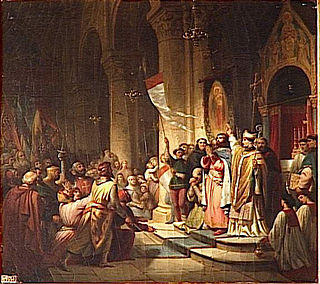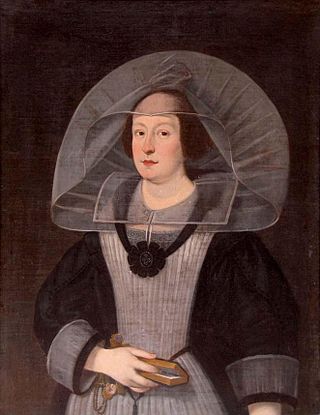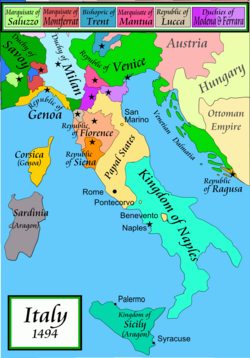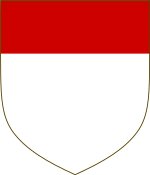
The House of Gonzaga is an Italian princely family that ruled Mantua in Lombardy, northern Italy from 1328 to 1708. They also ruled Monferrato in Piedmont and Nevers in France, as well as many other lesser fiefs throughout Europe. The family includes a saint, twelve cardinals and fourteen bishops. Two Gonzaga descendants became empresses of the Holy Roman Empire, and one became queen of Poland.

Federico II of Gonzaga was the ruler of the Italian city of Mantua from 1519 until his death. He was also Marquis of Montferrat from 1536.

Boniface I, usually known as Boniface of Montferrat, was the ninth Marquis of Montferrat, a leader of the Fourth Crusade (1201–04) and the king of Thessalonica.

The Duchy of Mantua was a duchy in Lombardy, northern Italy. Its first duke was Federico II Gonzaga, member of the House of Gonzaga that ruled Mantua since 1328. The following year, the Duchy also acquired the March of Montferrat, thanks to the marriage between Gonzaga and Margaret Paleologa, Marchioness of Montferrat.

Vincenzo Ι Gonzaga was the ruler of the Duchy of Mantua and the Duchy of Montferrat from 1587 to 1612.

Guglielmo Gonzaga was Duke of Mantua from 1550 to 1587, and of Montferrat from 1574 to 1587. He was the second son of Federico II Gonzaga, Duke of Mantua and Margaret Palaeologina of Montferrat. In 1574, Montferrat was elevated to a Duchy and Guglielmo became its first duke. He was succeeded as Duke of both duchies by his son Vincenzo.

Margaret of Savoy was the last Habsburg Vicereine of Portugal from 1634 to 1640. In Portuguese she is known as Duquesa de Mântua, being by marriage the Duchess of Mantua and Montferrat. She was also regent of Montferrat during the minority of her daughter from 1612.

Azalaïs of Montferrat (1150–1232) was Marchioness consort of Saluzzo by marriage to Manfred II of Saluzzo, and regent for her grandson, Manfred III of Saluzzo from 1215 to 1218.

The Duchy of Montferrat was a state located in Northern Italy. It was created out of what was left of the medieval March of Montferrat after the last Palaeologus heir had died (1533) and the margraviate had been briefly controlled by the Emperor Charles V. After that brief interlude, it passed by marriage of the last heiress, Margaret of Montferrat, to the House of Gonzaga, already dukes of Mantua. In 1574 the fief was elevated from Marquisat to Duchy.
Secondotto Palaeologus was the Margrave of Montferrat from 1372 to his death, the third of the House of Palaeologus-Montferrat. His name Secondotto may derive from his being the second Otto to rule Montferrat in his own right, though he would really be Otto III. More probably it is derived from Saint Secundus, the patron saint of Asti, which his father treated as the capital of the marquisate. The Otto may be in honour of Otto, Duke of Brunswick-Grubenhagen, a close ally of his father.

The Marchof Montferrat was a frontier march of the Kingdom of Italy during the Middle Ages and a state of the Holy Roman Empire. The margraviate was raised to become the Duchy of Montferrat in 1574.

Anne d'Alençon, Lady of La Guerche, was a French noblewoman and a Marquise of Montferrat as the wife of William IX, Marquis of Montferrat. She acted as Regent of the Marquisate of Montferrat for her son, Boniface from 1518 to his death in 1530.

Maria Gonzaga or Maria of Mantua was a reigning duchess of Montferrat from 1612 until 1660, and regent in Mantua during the minority of her son from 1637 until 1647.
Maria of Serbia or Marija Branković was Princess of Serbia by birth, and Marchioness of Montferrat by marriage. She was regent of Montferrat during the minority of her son in 1494-1495.

Margaret Palaeologa, was the ruling Marquise regnant of Montferrat in her own right between 1533 and 1536. She was also Duchess of Mantua by marriage to Federico II, Duke of Mantua. Margaret acted as the regent of the Duchy of Mantua twice during the minority of her sons: for her elder son Francesco III Gonzaga, Duke of Mantua in 1540-1549, and for her younger son Guglielmo Gonzaga, Duke of Mantua, between 1550 and 1556.

John George of Monferrat was the last Marquis of Montferrat of the Palaeologus-Montferrat family.

William IX Palaeologus was Marquis of Montferrat from 1494 until his death. He was a member of the House of Palaeologus-Montferrat, a cadet branch of the Palaiologos dynasty which had once ruled the Byzantine Empire.
Boniface III Palaeologus was Marquis of Montferrat from 1483 until his death.

The War of the Montferrat Succession was a war of succession from 1613 to 1617 over the Duchy of Montferrat in northwestern Italy.
This page is based on this
Wikipedia article Text is available under the
CC BY-SA 4.0 license; additional terms may apply.
Images, videos and audio are available under their respective licenses.
















